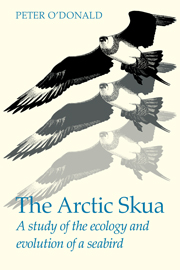Book contents
- Frontmatter
- Contents
- List of figures
- List of tables
- Preface
- 1 The Arctic Skuas of Fair Isle
- 2 Numbers and distribution
- 3 Feeding behaviour and ecology
- 4 Breeding ecology
- 5 Genetics
- 6 Demography and selection
- 7 Sexual behaviour
- 8 Sexual selection
- 9 Genetic models of sexual selection in birds
- 10 Mating preferences of the Arctic Skua
- 11 Conclusions
- Appendix A Rates of increase of bird populations
- Appendix B Analysis of variance of a 2 × r table with unequal numbers of observations
- Appendix C Statistical analysis of assortative and disassortative mating in polymorphic birds
- References
- Index
11 - Conclusions
Published online by Cambridge University Press: 21 May 2010
- Frontmatter
- Contents
- List of figures
- List of tables
- Preface
- 1 The Arctic Skuas of Fair Isle
- 2 Numbers and distribution
- 3 Feeding behaviour and ecology
- 4 Breeding ecology
- 5 Genetics
- 6 Demography and selection
- 7 Sexual behaviour
- 8 Sexual selection
- 9 Genetic models of sexual selection in birds
- 10 Mating preferences of the Arctic Skua
- 11 Conclusions
- Appendix A Rates of increase of bird populations
- Appendix B Analysis of variance of a 2 × r table with unequal numbers of observations
- Appendix C Statistical analysis of assortative and disassortative mating in polymorphic birds
- References
- Index
Summary
In this book I have described the results of my study of the population ecology and genetics of the Arctic Skuas on Fair Isle. When a population ecologist studies an organism, he asks questions, such as the following, about its population size and numbers:
(i) Are its populations stable, increasing, or decreasing?
(ii) Can future population changes be predicted?
(iii) How are population numbers regulated – for example, is regulation density-dependent?
Seeing a polymorphism, a population geneticist asks such questions as:
(i) What are the genetics of the polymorphism?
(ii) Is the polymorphism stable, or is it still evolving?
(iii) How are the gene frequencies spatially distributed – is their distribution uniform, or are there clines from one area to another?
(iv) What selective forces are acting on the phenotypes – natural selection, sexual selection, or both – and are they sufficient to ‘protect’ the polymorphism against extinction of alleles?
I hoped I might answer such questions when I set out to study the Arctic Skua and its striking polymorphism in plumage. In previous chapters – chapter 2 on population ecology, chapter 5 on genetics and chapters 6, 8 and 10 on natural and sexual selection, I have given some answers. Some answers are tentative: some – on the population changes and the natural and sexual selection of the population – are bold and decisive. Now, in this last chapter, I can omit the details of analysis, summarize the results, and draw general conclusions about the evolutionary forces that maintain the polymorphism.
- Type
- Chapter
- Information
- The Arctic SkuaA study of the ecology and evolution of a seabird, pp. 264 - 270Publisher: Cambridge University PressPrint publication year: 1983



